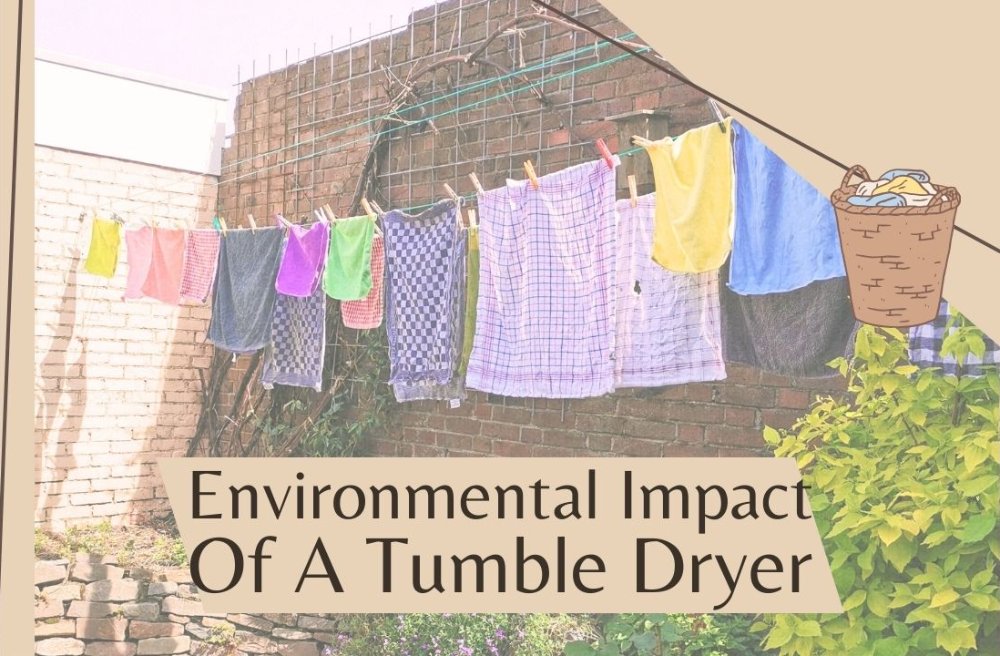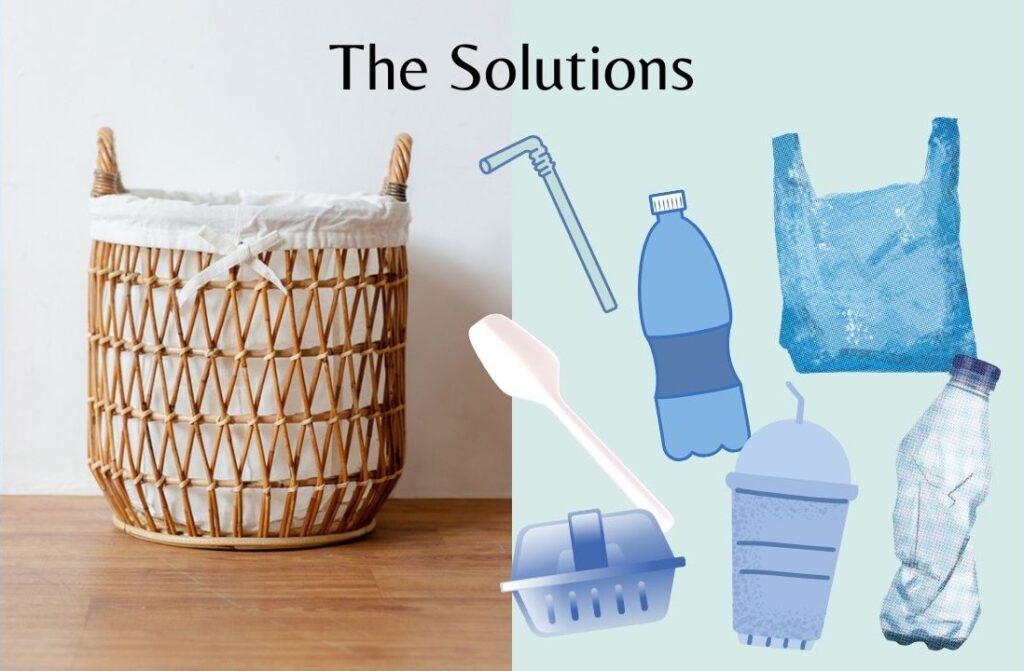Every choice we make can have a profound impact on the environment. When there’s a machine or tool that can make our daily lives easier and more comfortable, we are always quick to purchase it. But have we gone too far? Where do we draw the line between necessity and excessiveness? Maybe some of the products the corporate world is giving us, are not the best choice for us and the planet. In this article, we’re going to look at what tumble dryers are doing to our clothes and the environment, and why you should consider the natural and sustainable alternative to dry your laundry.
There are three main categories when looking at the negative impacts of a tumble dryer compared to line-drying: energy, wear & tear, and air quality. Let’s dive right in, because your clothes and the environment are on the line – okay, I’m done with the line-puns now.
#1. Energy Consumption: Carbon Emissions & Water
According to energy efficiency experts, tumble dryers are one of the most energy-intensive household appliances. They rely on substantial amounts of electricity to generate heat and circulate hot air in order to dry clothes quickly.
Why is this a problem?
Before you are able to turn on the dryer to finish the last step of your laundry routine, electricity has to be generated in a power plant. During this process, fossil fuels such as coal, gas or oil are burned, which results in large amounts of harmful greenhouse gases being released into the air, like carbon dioxide (CO2). These emissions pollute our environment and cause rising global temperatures.
Water Usage: a hidden environmental impact
By consuming electricity, a tumble dryer also indirectly consumes water and therefore contributes to global water scarcity.
Hold on..water? We’re talking about a dryer that is supposed to take water out of my laundry… How is water involved? Here’s the thing. Appliances that consume electricity, also require water. That’s because in addition to fossil fuels, there is another ingredient that is used in power plants to generate electricity: water. Lots and lots of water. It is mainly used to cool down the power plant after converting the heat from the burned fossil fuels into electricity. In the United States and the European Union, electricity generation is responsible for between 40% and 55% of the total water withdrawal.
There is a but
And the ‘but’ is renewable energy. If you power your home with renewable energy, such as with solar panels, then the electricity usage is not that big of an issue.
“Renewable energy is energy derived from natural sources that are replenished at a higher rate than they are consumed. Sunlight and wind, for example, are such sources. Fossil fuels – coal, oil and gas – on the other hand, are non-renewable resources that take hundreds of millions of years to form.”
Renewable energy is also often called green energy or sustainable energy, because almost no greenhouse gases are emitted during the generation process. So the mere act of using electricity to dry your clothes is not the problem. It’s how this electricity was made.
#2. Material Wear And Tear: Shortening Garment Lifespan
Tumble drying might be good for your lifestyle, but it’s certainly not good for your clothes. After you put your laundry in the dryer and go about your day, your clothes are subjected to rotation and high heat. In other words, your clothes are spun around while hot air dries them. These two actions are a disastrous combination, as they make your clothes more prone to fading, shrinking, and developing holes or pilling.
All this wear and tear shortens the lifespan of your garments which means you’ll have to replace them more frequently. And that in turn leads to additional resource consumption and waste generation. Let’s look at the main effects the tumble dryer has on your laundry.
Shrinkage
You probably already know the washing machine can shrink clothes. The dryer is also very capable of doing this. In fact, there are studies and experts that have stated the tumble dryer shrinks clothes even more than the washing machine. And contrary to what you may expect, the high temperature is not even the main issue. Shrinkage is mostly caused by the forced air and tumbling action.
In the case of natural materials like cotton, linen and wool, it’s also possible to go overboard and make the clothes too dry. These materials always have and should have some moisture, even if they feel dry. Cotton has a natural moisture content of around 5% and wool 17%. Over-drying and removing too much moisture will result in a shrunken garment, and it will weaken the material too.
Tears, Holes and Pilling
Clothes get damaged from friction and abrasion. This happens in daily life when you’re simply wearing them. Your jacket rubs against your shirt; trousers rub against the seat; swimwear rubs against sand etc. That’s normal and inevitable.
As garments are whirling around in the dryer, they are constantly rubbing against each other. You might not immediately notice the effect of this, but the dryer’s lint filter shows the harsh truth. The lint you find in the machine is made up of tiny fibers that your clothes lose during the drying cycle. Rubbing and abrasion basically causes the fibers in the fabric to become smaller and thinner.
You can also see lint form directly on your clothes. As the fibers are raised and pushed out from the surface due to the abrasion, they start to form into little lint balls or pills on the surface. I’m sure you have seen this before. This means the strength of the fabric will deteriorate too. The material will become weaker and easier to tear and rip, so you’ll have to be more careful when wearing a slightly too tight pair of jeans out in public (that brings back an embarrassing memory for me…)

So, over time this affects the appearance and quality of the garments, and eventually your clothes will fall apart when enough fibers have been torn and shed. The damage is irreversible and fibers can’t grow back, so every drying cycle ruins your clothes a little more.
As I said, this process will also happen from just wearing and using things, but the dryer accelerates this because you’re purposely exposing the clothes to more rubbing.
#3. Air Quality: Microfiber Pollution
Remember my 3-part series about microplastic pollution? In those articles, I mainly focused on microplastics that are released when using a washing machine. But the tumble dryer is also a big source of microfiber pollution.
Microplastic fibers are the fibers from synthetic materials like polyester and nylon. Microfibers is more of an umbrella term for fibers from any textile material, so also natural ones like cotton
The lint filter in the tumble dryer is there to catch the loose fibers, but not everything gets caught and not everyone gets rid of the lint in a responsible way. Some of the fibers are so small that they slip through the filters. This lint and dust will float around in the air and can be inhaled.
A study was done to measure how many microfibers are released when using a tumble dryer. The result was that one dryer could emit between 90 and 120 million microfibres into the air every year. In the case of natural materials like cotton, this is not that big of a problem because these can decompose and be digested by animals. If you own clothes made from plastic-based materials like polyester and nylon, then your dryer is contributing to global microplastic pollution.
Prolonged exposure to indoor air pollutants can have adverse effects on respiratory health and indoor air quality. Check out this post to learn more about the dangers and consequences of microplastic pollution.
The Sustainable Alternative: The Power Of Nature
There is a better way to dry and it’s one that has been around for much longer than an electric dryer. As is the case with many inventions from the past hundred years, this appliance was created for convenience without thinking about the longer-term effects for the environment. The earth already provides everything we need in nature. The air and sun can do the job for free, with minimal impact on your garments.
Air drying on a clothesline or rack offers a sustainable and environmentally friendly alternative for drying clothes. Let’s look at the main differences compared to tumble drying.
Energy Consumption
Line-drying requires no electricity, relying instead on natural air circulation and sunlight to evaporate moisture from fabrics.
As I said before, tumble dryers are one of the most energy-heavy appliances in an average household. There are more appliances in this category, such as the washing machine, dishwasher and refrigerator. Some of these will be difficult to live without, like a fridge or even a washing machine, but a dryer is an extra tool to help you do your housework and it can easily be done without.
You can see a big difference on your energy bill if you start using the dryer less often. At the same time, you can reduce your own carbon footprint and indirectly minimize water usage.
Wear And Tear
All clothes will be worn out over time and will need to be replaced eventually. The sooner a garment is worn to shreds, the sooner a new one has to be made and bought. I always say the main goal for creating a sustainable fashion industry, is to minimize the use of new resources. In simpler terms: to make as less new clothes as possible. A tumble dryer adds additional wear and tear and hastens the deterioration process. You’re basically making the decision to damage the clothes quicker for the sake of convenience and time.
Hanging your laundry to dry instead is much more gentle on the fabrics and will help preserve the quality longer. This way, you can extend the lifespan of your clothes and enjoy them for much longer.
Final Thoughts
The tumble dryer allows you to speed up the laundry process, but at the expense of your clothes and the environment. It’s one of those things where you have to weigh convenience and time efficiency against sustainability.
For some of us, a dryer is a real lifesaver in our busy lives. I personally never use a tumble dryer and I’m doing fine. Now, I also don’t have kids, I don’t live in a flat without an outdoor space, and I don’t have to do laundry every day, so I understand I can’t relate to everyone and expect you all to get rid of your tumble dryer.
But I do want to challenge you to ask yourself this question: is the tumble dryer for you a necessity or a luxury? If you’re so used to the tumble dryer, your immediate answer may be that it’s a necessity. But I want to ask you to really think about it. Is it always necessary or only on some days? Chances are that it’s become such an integral part of your routine that you don’t even think about it anymore and unconsciously also use it on days that you could’ve line-dried.
You might also have a preconceived notion about the time line-drying actually takes. Yes, it takes a few hours for your laundry to dry, whereas the tumble dryer can get it done in less than an hour. But you don’t have to stand there next to the line and watch the clothes dry. You just need 10-20 minutes to hang the laundry on the line or rack. After that you can continue your day and come back to take them off whenever you have some time again. All the steps after are the same as with tumble drying.
If you do conclude that you really need the dryer, try to reduce the amount of times you use it. Consider with each use whether the other option is possible or not.
Are you team tumble dryer or air drying? Let me know in the comments!
If you want to learn more about how to make your laundry process more sustainable, you can read part 3 of my microplastics series! How To Reduce Microplastic Pollution From Our Clothes
Sources
Energy Saving Trust. (2022, January 14). Top five energy consuming home appliances. Retrieved from www.energysavingtrust.org.uk: https://energysavingtrust.org.uk/top-five-energy-consuming-home-appliances/
Lohrmann, A., Child, M., & Breyer , C. (2021). Assessment of the water footprint for the European power sector during the transition towards a 100% renewable energy system. Energy.
United Nations. (2024, April). What is renewable energy? Retrieved from www.un.org: https://www.un.org/en/climatechange/what-is-renewable-energy
Salant, K. (2004, November 5). Heat Didn’t Shrink That Shirt: Fabric Expert Offers the Scoop. The Washington Post.
Banfield-Nwachi, M. (2022, January 12). Tumble dryers found to be a leading source of microfibre air pollution. The Guardian.





